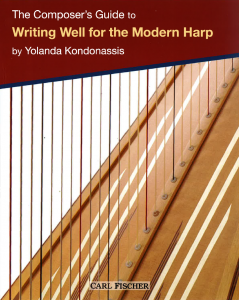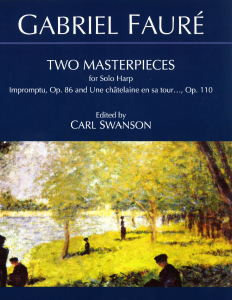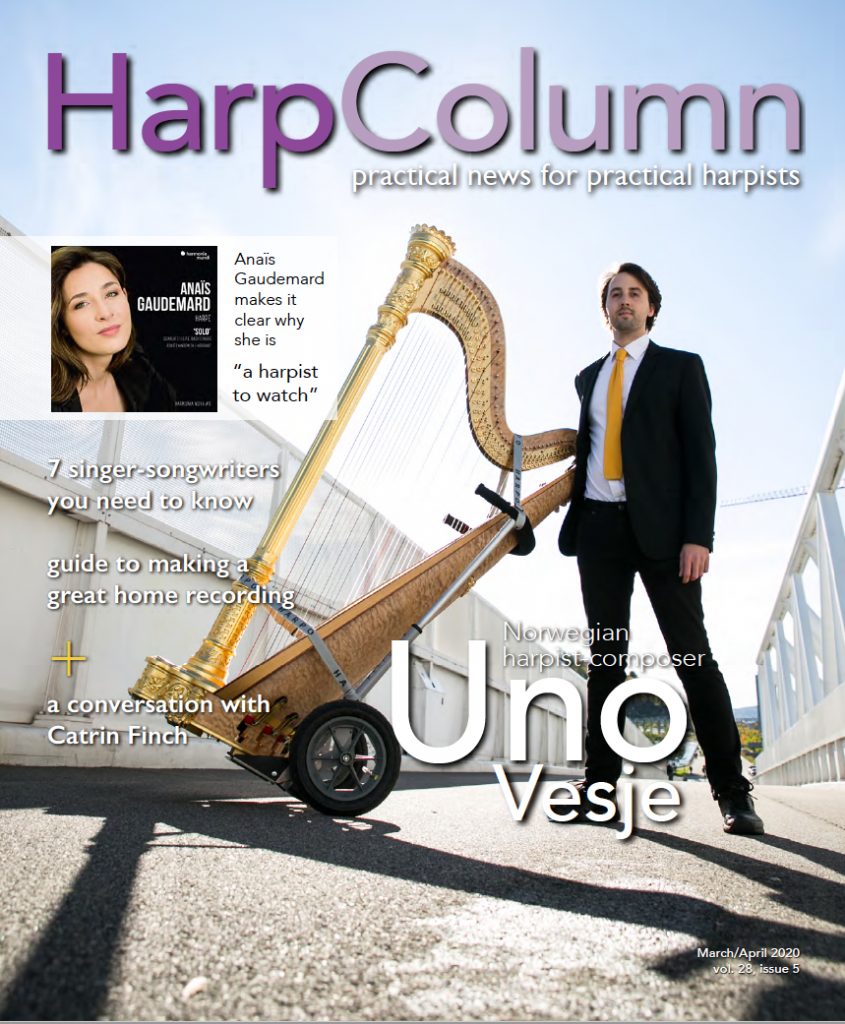It has been a while since I read a book in one sitting. The last time might have been when I was 13 years old and read Jane Austen’s Pride and Prejudice. I recently read a beautifully printed book entitled Writing Well for the Modern Harp cover to cover and enjoyed every page. The author is famous harpist and pedagogue Yolanda Kondonassis, and the book was recently published by Carl Fischer.

I was very curious to read a new take on the long-discussed subject of composing for the double-action harp. The idea of writing a harp manual for composers of music that involves harp goes back decades. It had been the goal of many noteworthy publications such as Lawrence and Salzedo’s Method for the Harp, Stanley Chaloupka’s Harp Scoring, and two editions of Writing for the Pedal Harp: A Standardized Manual for Composers and Harpists by Ruth K. Inglefield and Lou Anne Neill. Kondonassis’ new manual follows this tradition and substantially adds to it.
Kondonassis introduces her book saying, “This is not a collection of rules and formulas—it is an honest conversation and a clear explanation of as many scenarios as possible, along with a hearty dose of solid advice.” All true.
Each chapter of the book clearly presents information about the harp and harp technique. It contains a brief history of the instrument, an explanation of its technical possibilities, a list of basic notation and traditional effects, and possible special sound effects, just to mention a few topics. The book is full of very clear examples of how to realize some musical ideas using reasonable, technical solutions. I loved seeing many examples of “unfeasible writings” followed by “feasible alternatives,” as well as an explanation of pedals and chromaticism, (i.e., thinking like a harpist). All of these suggestions are highly helpful, not only for composers, but also for harpists taking up the challenge of transcribing for the harp. Kondonassis deserves the highest mark for such a deep presentation of this very difficult subject.
Some minor critical points: There was a missed opportunity to firmly indicate that harpists not only prefer, but want to have their harmonics notated where they are played, not where they sound. This approach would finally put to rest Carlos Salzedo’s suggestion of notating harmonics where they sound, which can be found in his Method for Harp first published in 1929. This particular view that Salzedo himself applied only to a few of his own compositions has become a source of confusion for many composers and harpists alike.
Another observation touches on the tradition of notating pedal changes in the score. I believe that many harpists (myself included) prefer pedal changes notated in the middle between the clefs instead of notating them below the staff as suggested.
These comments aside, the bottom line is that I find Kondonassis’ book the single best source I can think of to recommend to anyone interested in composing or transcribing for the modern harp. It is extremely well structured, very informative, fun to read, and full of great musical examples. It also contains a complete glossary of over 50 “special effects” clearly pictured and explained. Finally, genuinely funny and apt cartoons created by Jeffrey Curnow delightfully enhance the book. Big thumbs up!

Another wonderful addition to the “must have” harp library is Gabriel Fauré’s Two Masterpieces for Solo Harp: Impromptu, Op. 86 and Une châtelaine en sa tour, Op. 110, beautifully edited by Carl Swanson and published in one volume for the first time by Carl Fischer.
As in his previous editions of Debussy’s Danses and Ravel’s Introduction and Allegro, Swanson shares with us his deep knowledge of the history behind the creation of each of the pieces, as well as his unique knowledge of details regarding incorrect notes and general pedal and dynamics markings. The scores are typeset in a very clear and easy-to-read way and include all pedal markings and pedal diagrams. Swanson spells out all of the enharmonics in his editions, which facilitates both reading and learning. Swanson gives a healthy dose of fingering in both scores, while leaving space for writing our own.
The preface included in the score is a priceless source of information of the historical context surrounding the creation of Fauré’s work. Swanson’s commentary also includes corrections for the Châtelaine score as well as Swanson’s English translation of Paul Verlaine’s poem number VIII “Une Sainte en son auréole,” the second line of which became the title of Fauré’s work. Another great part of the preface is his discussion of the mystery concerning Impromptu, which I found fascinating. The final note is that Swanson is very faithful to the original version of the compositions, not adding or altering musical indications and notes.
As a harpist and teacher, I am very grateful for Swanson’s edition. It is not only beautifully edited and published, but it also gives lots of historical program notes about each piece that are extremely useful for the performer. Another thumbs up! •






